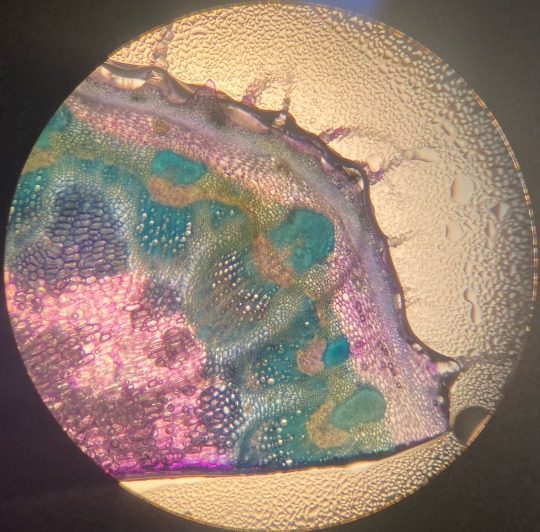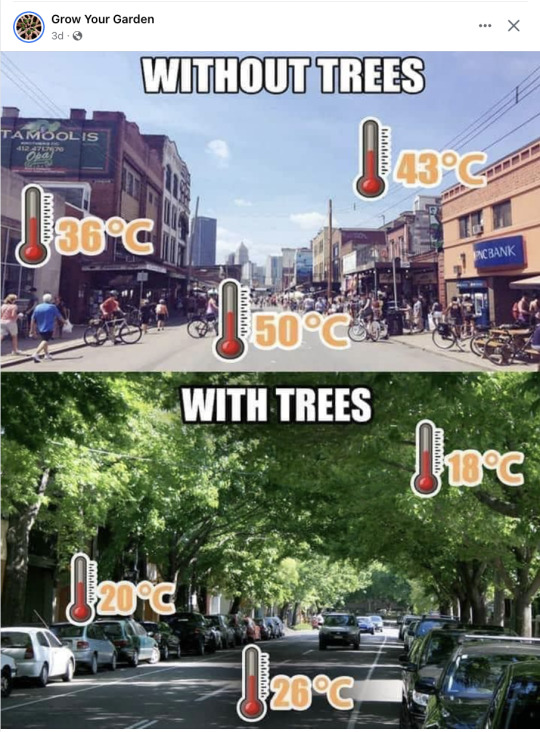#plant sciences
Explore tagged Tumblr posts
Text

Your summer reading list: Natural History of Vacant Lots - 1987.
#books#reading#vintage illustration#vintage books#book covers#reading lists#summer reading#books and reading#science#nature#science and nature#botany#plants#botanist#fields#lots#plant science#plant biology#phytology#plant sciences#phytologist#pastures
25 notes
·
View notes
Text

sunflower stem cross section with TBO dye
25 notes
·
View notes
Text
If you're feeling anxious or depressed about the climate and want to do something to help right now, from your bed, for free...
Start helping with citizen science projects
What's a citizen science project? Basically, it's crowdsourced science. In this case, crowdsourced climate science, that you can help with!
You don't need qualifications or any training besides the slideshow at the start of a project. There are a lot of things that humans can do way better than machines can, even with only minimal training, that are vital to science - especially digitizing records and building searchable databases
Like labeling trees in aerial photos so that scientists have better datasets to use for restoration.
Or counting cells in fossilized plants to track the impacts of climate change.
Or digitizing old atmospheric data to help scientists track the warming effects of El Niño.
Or counting penguins to help scientists better protect them.
Those are all on one of the most prominent citizen science platforms, called Zooniverse, but there are a ton of others, too.
Oh, and btw, you don't have to worry about messing up, because several people see each image. Studies show that if you pool the opinions of however many regular people (different by field), it matches the accuracy rate of a trained scientist in the field.
--
I spent a lot of time doing this when I was really badly injured and housebound, and it was so good for me to be able to HELP and DO SOMETHING, even when I was in too much pain to leave my bed. So if you are chronically ill/disabled/for whatever reason can't participate or volunteer for things in person, I highly highly recommend.
Next time you wish you could do something - anything - to help
Remember that actually, you can. And help with some science.
#honestly I've been meaning to make a big fancy thorough post about this for literally over a year now#finally just accepted that's not going to happen#so have this!#there's also a ton of projects in other fields as well btw#including humanities#and participating can be a great way to get experience/build your resume esp if you want to go into the sciences#actual data handling! yay#science#citizen science#climate change#climate crisis#climate action#environment#climate solutions#meterology#global warming#biology#ecology#plants#hope#volunteer#volunteering#disability#actually disabled#data science#archives#digital archives#digitization#ways to help#hopepunk
26K notes
·
View notes
Text
Unlock Your B.Sc. (Hons) in Horticulture at Mangalayatan University
Pursue your B.Sc. (Hons) in Horticulture at Mangalayatan University, Jabalpur, and gain hands-on expertise in sustainable agriculture, plant sciences, and modern horticultural techniques. Build a thriving career with our industry-relevant curriculum and experienced faculty.
ADMISSION HELPLINE:
Call/WhatsApp: +91-8252-300-300, 8252 200 200
Email: [email protected]
0 notes
Text










To plant a garden is to believe in the future. To preserve the gardens of our world is to prepare for its uncertain future.
Please send your love to Duke Herbarium's professors, staff, and students during this trying time. Follow them on Insta @bluedevil.herbarium
#botany#plant sciences#plants#herbarium#duke herbarium#if we kill our herbaria#we lose the history of our biodiversity and ability to study it in the future
0 notes
Text

Me if I were a dog.
18K notes
·
View notes
Photo

70K notes
·
View notes
Text

“It is not so much for its beauty that the forest makes a claim upon men’s hearts, as for that subtle something, that quality of air that emanation from old trees, that so wonderfully changes and renews a weary spirit.”
― Robert Louis Stevenson
Source: Grow Your Garden Instagram page
#katia plant scientist#botany#plant biology#plant science#plants#trees#plants make people happy#sustainability#ecological#solarpunk#intersectional environmentalism#environmentalism
28K notes
·
View notes
Text

When it rains the white petals of Diphylleia Grayi also known as skeleton flowers, turn crystal clear.
37K notes
·
View notes
Text

Imagine a pinecone as heavy as a bowling ball and the size of a chihuahua. Believe it or not, such pinecones exist—and they belong to the coulter pine (Pinus coulteri), a conifer that can be found in parts of North America including California and Mexico. Infamous among loggers and foresters, this tree is nicknamed "the widowmaker" because of the unlucky individuals who met their fate as a result of its falling pinecones. This species produces some of the largest pinecones on the planet, weighing up to 11 lbs (5 kg).
Photo: damontighe, CC BY-NC 4.0, iNaturalist
#science#nature#natural history#fact of the day#did you know#plants#pine cones#fun facts#trees#conifer#pine trees
3K notes
·
View notes
Text


Matcha-microbiology 🧪
#my art#artists on tumblr#kawaii#cute#aesthetic#matcha#chemistry#chemist#biology#biologist#science#microbiology#mibi#green#plants#art#Illustration#drawing#procreate art
1K notes
·
View notes
Text
A rare species of tree cactus has gone extinct in Florida, in what is believed to be the first species lost to sea level rise in the United States, researchers said Tuesday. The Key Largo tree cactus (Pilosocereus millspaughii) was restricted to a single small population in the Florida Keys, an archipelago off the southern tip of the state, first discovered in 1992 and monitored intermittently since then. But salt water intrusion caused by rising seas, soil erosion from storms and high tides, and herbivory by mammals placed significant pressure on the last population.
Continue Reading.
#Science#Plants#Environment#Climate Change#Extinction#Pilosocereus Millspaughii#Key Largo Tree Cactus
1K notes
·
View notes
Text
"A surprise discovery from the University of Birmingham shows that we may be significantly underestimating the potential of trees to regulate the variables of climate change.
That’s because they found microbes living inside trees’ bark absorb the greenhouse gas methane about as significantly as microbes living in the soil.
It’s long been thought that soil is the only effective terrestrial methane sink, as certain microorganisms use methane as a food source, but similar creatures live under a tree’s layer of bark, meaning that not only do our woody cousins withdraw CO2 from the atmosphere and store it in their roots, but also remove methane as well, about as effectively or perhaps more so than soil.
Methane is a potent greenhouse gas for the few short years it exists in the atmosphere before degrading.
Professor Vincent Gauci of U. Birmingham led the study, published in the journal Nature.
In the study, the researchers investigated upland tropical, temperate, and boreal forest trees. Specifically, they took measurements spanning tropical forests in the Amazon and Panama; temperate broadleaf trees in the UK; and boreal coniferous forests in Sweden.
The methane absorption was strongest in the tropical forests, probably because microbes thrive in the warm wet conditions found there. On average the newly discovered methane absorption adds around 10% to the climate benefit that temperate and tropical trees provide.
By studying methane exchange between the atmosphere and the tree bark at multiple heights, the researchers were able to show that while at soil level the trees were likely to emit a small amount of methane, from a couple of meters up the direction of exchange switches and methane from the atmosphere is consumed.
In addition, the team used laser scanning methods to quantify the overall global forest tree bark surface area, with preliminary calculations indicating that the total global contribution of trees is between 24.6-49.9 Tg (millions of tonnes) of methane. This fills a big gap in understanding the global sources and sinks of methane.
“Tree woody surfaces add a third dimension to the way life on Earth interacts with the atmosphere, and this third dimension is teeming with life, and with surprises,” said co-author Yadvinder Malhi of the University of Oxford."
-via Good News Network, July 31, 2024
#trees#forests#tree bark#methane#global warming#emissions#plant biology#soil#microbes#microbiology#climate news#climate science#good news#hope
905 notes
·
View notes
Text
Inside the Squirting Cucumber

Though only 5 cm long, the squirting cucumber can spray its seeds up to 10 meters away. The little fruit does so through a clever combination of preparation and ballistic maneuvers. (Research and image credit: F. Box et al.; via Gizmodo) Read the full article
477 notes
·
View notes
Note
Planning on becoming a biology teacher and whenever i see your posts it just gives me a motivation boost, it's so very interesting and i'm so very glad there's a blog for it 💕
String identified: ag cg a g tac a t t t g a tat t, t' ttg a ' ga t' a g t 💕
Closest match: Vitis vinifera cultivar Black Monukka isolate seedless chromosome 16 Common name: Common Grape Vine

(image source)
#tumblr genetics#genetics#biology#science#asks#starstepper#plants#flowers#food#edible#grapes#common grape vine
531 notes
·
View notes
Text
Okay, so this is really cool! You have this phenomenon where some plants grow edible appendages to their seeds to entice ants to carry them underground where they can safely sprout. And then you have wasps which lay their eggs on the leaves, stems, and other parts of plants and trigger the growth of galls (swellings) which both feed and protect the wasp larvae until they reach maturity.
The boy who was watching the ants noticed they were taking wasp galls underground, too. Further exploration found that the wasp larvae were unharmed inside the galls; the only thing the ants had eaten were edible appendages similar to those on the seeds they collected. The wasp larvae stayed safe inside the ant nest, feeding on their galls, until it was time to emerge and head back out to the surface.
So it turns out that the edible portions of the galls have the same sorts of fatty acids as the edible parts of the seeds. And those fatty acids are also found in dead insects. Scientists think that the wasps evolved a way to make the galls they created mimic the edible portions of the seeds to get the ants to collect the galls. This isn't the only example of wasps making use of ants as caretakers for their young, but it's a really fascinating example thereof--especially if you consider ants evolved from wasps at least 100 million years ago.
#wasps#ants#plants#galls#oak galls#insects#invertebrates#Hymenoptera#ecology#bugs#animals#wildlife#nature#trees#entomology#science#natural science#evolution#animal behavior
13K notes
·
View notes